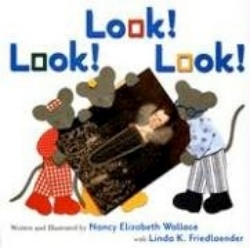Look! Look! Look!
These three mice are anything but blind. They find a postcard in their humans’ house and borrow it for a while to examine it. The postcard depicts an elegantly dressed lady—the Portrait of Lady Clopton, painted around 1600 by Robert Peake. The anthropomorphized mice—Kiki, Alexander, and Kat—look at the painting in several different ways, offering children ages five through eight a sweet introduction to art appreciation.
The mice cut little paper viewing frames, and focus on separate details of the painting, like the lady’s hands or jewels; then they notice patterns in the lady’s clothing and compare them to their own clothing. Kiki describes the colors she sees in the painting, and notes the colors that are absent. Alexander says, “I see the lady another way,” and points out the lines in the portrait. “‘Look!’ they all squeaked. ‘The lady can be lines!’”
Kat observes shapes—the lady’s dress is a triangle and a trapezoid, and the stylish ruff around her neck is formed from raindrops. The mice cut out paper shapes, rearrange them into other designs, and then make a mouse version of the painting. Soon they hear the humans returning, and scurry to return the postcard, so the cleverly named Bigley family can find it and exclaim, “Look!”
The author has written and illustrated more than a dozen children’s books, including Recycle Every Day!, Seeds! Seeds! Seeds!, and Leaves! Leaves! Leaves!, which was a Society of School Librarians’ Book Award Honor Book and winner of the 2003 Best Children’s Book of the Year from Bank Street College. Her cut-paper illustrations are vibrant and charming, and the juxtaposition of the impish mice and the imposing Lady Clopton is comical and endearing—and instructive.
Wallace gives interactive workshops around the nation, guiding children and adults in exploring art appreciation as Kiki, Alexander, and Kat do—using their eyes, imaginations, and paper and scissors. For this book, she collaborated with the curator of education at the Yale Center for British Art. Friedlaender conducts museum programming and outreach, designing art-education curricula for classrooms and museums. The original Portrait of Lady Clopton is part of Yale’s collection.
In addition to the lessons subtly delivered through the story of the mice, the book’s creators include direct teaching tools: a glossary, which defines the art terms color, line, pattern, and shape; plus instructions for an activity making portrait postcards. A discussion of texture would have been an asset, especially since both Wallace’s cut-paper art and Peake’s oil-paint art are highly textured—the mice look fuzzy, and Lady Clopton’s gown is satiny.
This book is a superb combination of delightful story, brilliant illustration, and age-appropriate teaching. It could inspire a whole new generation of artists and art lovers.
Reviewed by
Karen McCarthy
Disclosure: This article is not an endorsement, but a review. The publisher of this book provided free copies of the book to have their book reviewed by a professional reviewer. No fee was paid by the publisher for this review. Foreword Reviews only recommends books that we love. Foreword Magazine, Inc. is disclosing this in accordance with the Federal Trade Commission’s 16 CFR, Part 255.

